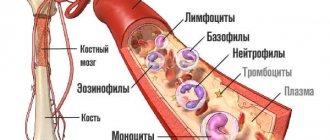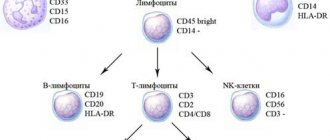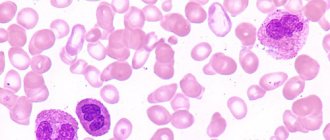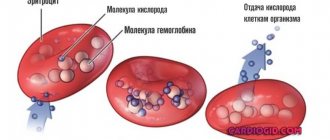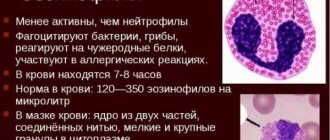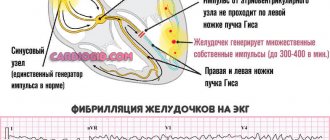Many people would like to know when a general blood test indicates that neutrophils are low in an adult, what this means, and whether it is worth seeing a doctor. A decrease in neutrophils in the blood can be caused by illness, a side effect of medications, or congenital pathology. To determine the factor that provoked the changes, you should conduct an examination with a specialist.
What are neutrophils
It is one of the 5 major subpopulations of leukocytes or white blood cells. In the body they perform an immune function. Each type of cellular elements of the blood has its own role, the main sphere of their action is protection from internal and external pathogenic microorganisms, foreign substances, and waste waste. Neutrophils are the most numerous category of cells of the leukocyte series (55-75% of the total).
In accordance with the division according to morphological characteristics, they are granular leukocytes (granulocytes). They got their name due to the fact that when stained for the purpose of studying using a microscope, they are able to perceive different dyes. These representatives of leukocytes have several synonyms - segmented neutrophils, neutrophilic granulocytes.
Characteristics of neutrophils
Neutrophils are formed in the bone marrow, where the cell reserve is concentrated. According to a specific signal from the body, they are released into the bloodstream (about 1% is found in the blood). Then, passing through the wall of the capillaries, they enter the tissue structures of the body, where they die. The total lifespan of neutrophils is on average 15 days: in tissues - 2 days, half-life of circulation in the blood - 6-7 days. Cells are mobile, capable of exhibiting a motor response to a chemical stimulus, migrating towards the site of inflammation, and independently moving to the site of damage.
Types of neutrophil granulocytes
There are 3 types of neutrophils.
They differ in the degree of maturity and the presence of a segmented core. Cells are isolated:
- young (developing) – may be absent or their content does not exceed 0.5%;
- rod (functionally immature forms) – account for 1-5%;
- segmented (mature) – the predominant part. They account for up to 78% of all leukocytes circulating in the blood.
In the case of pathology, infection, or inflammatory process, in response to stimulation, cell division starts, and young neutrophil granulocytes appear in the blood. By the presence and number of such cells in the circulation, the presence of blood loss, the pathological process and its activity, the body’s protective reaction and the ability to fend for itself are judged. The effect of the stimulus can be observed after several hours or days.
If segmented neutrophils are reduced, and young cells predominate (this condition is called a shift of the formula to the left), then this is prognostically unfavorable in terms of protecting the body, because immature forms do not have sufficient functional activity.
Functions of leukocytes
The basis of the human body's immune system are leukocytes, which come in several types. These blood cells prevent infection from infecting healthy cells.
Leukocytes are divided into several types with different functions:
- T-lymphocytes guarantee cell immunity and eliminate foreign microorganisms and defects. In addition, they provide resistance to infections, promote blood formation, and also control the functions of B lymphocytes.
- B lymphocytes protect the body from bacterial and viral infections by producing antibodies. Cells of this type give the immune system the ability to remember. Once, faced with a harmful microorganism, information about it is postponed, and along with it, methods for its destruction. Subsequently, the cells transmit information by inheritance.
- Monocytes are the orderlies of the immune system, absorbing parasitic remains of the products of active cell activity. They not only cleanse the body of pests, but also transmit information about them to new cells.
When leukocytes work together and properly, the human body is maintained in a healthy state.
Leukocytes, according to their morphological properties, are divided into 2 units:
- granulocytes are granular particles of blood, the main of which are neutrophils;
- agranulocytes.
The number of lymphocytes in the blood is an important indicator of a healthy body. Reduced levels indicate immunodeficiency, while high values indicate autoimmune abnormalities or excessive immune function. The reasons for deviations are found only with additional research.
Why are neutrophils needed?
Among leukocytes, these are the most powerful enzyme-formers. They have a direct effect on particles that threaten the body and an indirect effect, which is realized through the release of active enzymes that have a destructive effect on foreign bodies. Neutrophils are considered the main functional link of cellular immunity and are classical phagocytes.
This is the name given to unique cells that protect the body by absorbing and neutralizing harmful agents. They are dying cells, tissue decay products, bacteria, viruses and everything foreign.
The role of neutrophils is reduced to the following functions:
- ensuring the safety of the body - antiviral effect, destruction of bacterial infection, gram-negative pathogenic microflora;
- cleansing the source of inflammation, preventing its spread;
- participation in the processes of hemostasis, protein metabolism, transfer of antibodies and vitamin B12;
- interaction with other immune cells, regulation of their activity;
- stimulation of tissue regeneration.
How is a deviation from the norm detected?
You can find out that the level of neutrophils is abnormal and low by examining the composition of the blood. In clinical practice, a general (detailed) analysis is carried out for this purpose - the most common and simplest.
Includes several indicators important for assessing the state of the immune system:
- WBC (which means white blood cells) – the absolute value is indicated, i.e. total number of leukocytes.
- Leukocyte indices - the relative content of neutrophil cells, expressed as a percentage, is calculated.
- Leukocyte formula - the percentage of the main subpopulations of leukocytes in a blood smear is calculated.
Description of the blood donation procedure
The material for the study is whole blood. A venous fence or a fingertip is used. Adding the anticoagulant EDTA to the sample prevents the blood from clotting. The sampled blood is analyzed in a clinical diagnostic laboratory using an automatic hematology analyzer. The device is intended for qualitative and quantitative research of blood cells.
If the device issues a warning about the detection of abnormal cells, low neutrophils, or the presence of other abnormalities, then to eliminate the error, a microscopic examination method is additionally used - viewing a blood smear on a glass slide under a microscope. Manual microscopy allows:
- study morphology (shapes, structure);
- clarify the leukocyte formula by highlighting subpopulations of neutrophils (young, mature cells) when counting;
- determine the exact number of pathological forms (with division).
Rules for preparing for research
In order for the result to be correct, you should prepare for the analysis. The list of requirements is exhaustive, the patient must:
- Stop drinking alcohol, avoid intense psycho-emotional and physical stress (24 hours before sampling).
- Limit consumption of fatty foods (1-2 days in advance).
- Discuss with your doctor which medications should be avoided on the eve of blood donation.
- Arrive on an empty stomach (8-14 hours of fasting), you are allowed to drink clean still water.
- Do not smoke for 1-2 hours before entering the treatment room, 10-15 minutes. It is advisable to sit quietly.
Deadlines
How long to wait for results depends on the laboratory. The execution time is negotiated, usually it is 1-2 working hours. day. Some clinics provide, in this case, results processed by professional specialists can be ready in as little as 2 hours.
Preparing for the study
The process of preparing for analysis consists of meeting certain conditions:
- Refrain from any food 12 hours before your appointment, this does not apply to liquids.
- Stop physical activity and avoid stress.
- For 2 days before the test, do not eat fatty or fried foods, drink alcohol, or smoke.
- Stop using any medications for 3-4 days. If taking medications is vital, you must notify your doctor.
If the patient is undergoing a comprehensive examination, then blood is first taken for a general analysis. Other diagnostic procedures are carried out later.
Decoding the analysis results
The results are recorded on a blood test form issued to the customer. Indicated:
- name of the medical organization;
- patient information;
- determination method;
- parameters under study;
- format for presenting results;
- units.
A complete picture is given by assessing the absolute number of neutrophil cells and their relative percentage to the total mass of leukocytes. Options for expressing absolute concentration (each laboratory has its own units of measurement):
- SI – international system of units;
- 10^9 cells/l, gigacells/liter (G/l);
- 10^3 cells/µl.
It is important to understand that if neutrophils (their total number) are reduced, then an increase in other leukocytes is usually observed. They add up to 100%. The analysis is carried out in totality of all main indicators. When assessing the condition of the blood and the ratio of different types of white blood cells, several criteria are used. To diagnose the pathology, the specialist takes into account the number and age of neutrophils - young or mature forms predominate. Cell imbalance can be temporary and easily corrected or indicate a pathological process.
It should be borne in mind that conclusions made by specialists about the discrepancy between the result and normal values cannot be considered as a diagnosis. It is also prohibited to use the information contained in the form for self-medication, independent interpretation, or searching for the causes of low neutrophils. The interpretation and formulation of an accurate diagnosis should be carried out by the attending physician after a comprehensive examination.
Diagnostics
In order for the doctor to understand why band neutrophils are normal and segmented neutrophils are low, a thorough diagnosis is necessary. The quantitative indicator of immature cells is influenced by various factors. Deviation, both downward and vice versa, signals the development of pathological processes in the individual’s body, which are accompanied by a rather sharp deterioration in his condition. To make a diagnosis, doctors will also be interested in the values of indicators such as:
- leukocytes;
- basophils;
- monocytes;
- eosinophils;
- mature neutrophils.
It is recommended to determine the level of immature cells in the following situations:
- after surgery - to analyze the effectiveness of therapy and wound infection;
- when coughing - an increased amount indicates the bacterial nature of the infection;
- prolonged increase in temperature;
- before prescribing antibacterial medications - in the future this will help determine the effectiveness of therapy (the absence of a decrease in neutrophils will indicate the development of complications);
- the presence of a clinical picture characteristic of acute respiratory infections.
Normal indicators
During the day, the bone marrow normally produces 0.62-4 billion neutrophils per 1 kg of weight. Even during the day, the number of neutrophils in the body of a healthy person can change significantly. Therefore, if there are minor deviations from the reference values, there is no need to worry. It is also important that the indicators are analyzed in terms of age norms. Due to the active formation of the immune system in childhood, the level of neutrophil granulocytes is higher, and the percentage of mature cells is lower. The standards are practically independent of gender (the same for female and male children, slightly different for adults; during pregnancy, the concentration of neutrophils increases).
Each laboratory sets its own reference intervals; these ranges may differ. In most cases, the following numbers are accepted as the norm:
- relative content of rod cells – 1-5%;
- the absolute number of segmented cells and their percentage - depending on age.
Acceptable intervals for children and adults are presented in the table.
| Age | Concentration, thousand/µl | Relative content, % |
| 1-2 days | 2-13 | 31-56 |
| 2-15 days | 1,8-7,5 | 31-56 |
| 0.5-12 months | 1-8,5 | 17-51 |
| 1-4 years | 1,5-8,5 | 29-61 |
| 4-10 years | 1,5-8 | 33-66 |
| 10-15 years | 1,8-7,7 | 46-66 |
| 15-21 | 1,8-7,7 | 48-78 |
| over 21 years old | 1.78-5.38 (men) 1.56-6.13 (women) | 48-78 |
Traditional medicine recipes
You can increase your immunity with the help of various folk remedies, using medicinal balms, herbal preparations and infusions. This is especially true in autumn and winter, when the risk of disease is greatest.
To make such balms, plant components are used:
- aloe;
- nuts, honey, lemon;
- cranberries and apples.
To make aloe balm, you need to find a plant that is at least 3 years old. Before cutting the leaves, it is not watered for 2 weeks.
The method of preparing the medicine consists of the following steps:
- Dry 0.5 kg of aloe plant leaves and place in the refrigerator for 5 days.
- The leaves are ground in a meat grinder to obtain ½ cup of a porridge-like mixture.
- Add ½ cup of honey, 300 g of Cahors.
- Mix everything thoroughly.
- Use 3 times a day before meals.
An effective remedy for treating wounds in the oral cavity is sage, which has anti-inflammatory properties.
It’s easy to prepare this infusion:
- 2 tsp. sage pour 400 ml of boiling water.
- Wrap the infusion with a warm blanket and leave for 2-3 hours.
- Strain the mixture and rinse your mouth.
Vitamin drinks strengthen the immune system and are a preventive measure against viral infections. Herbal infusions have an ideal effect on the human body.
To prepare medicinal decoctions, you will need:
- valerian root;
- hop cones;
- Linden;
- motherwort;
- Melissa and others.
Warm baths with the addition of various herbs are recommended. Usually dry branches and leaves of bushes are used: currants, rose hips, raspberries. A decoction of rowan and lingonberry leaves added to the bath has beneficial properties.
Reduced neutrophil levels: what does it mean?
A condition characterized by a low level of neutrophils in the peripheral blood is usually referred to as neutropenia. Pathology is indicated by a significant decrease in the concentration of neutrophils below the threshold value, i.e. when it is less than 1.5x10^3 cells in 1 microliter.
Neutropenia occurs:
- a consequence of another disease, congenital disorders of blood production;
- the result of external factors;
- independent syndrome or acts as a primary disease.
If in an adult neutrophils are reduced more significantly - a level of less than 500-750 granulocytes per 1 μl is considered abnormally low, then this condition is conventionally mistaken for agranulocytosis or granulocytopenia (clear separation criteria have not been developed).
What is the danger of downgrading?
What happens in the body against the background of a disturbance in the composition of the blood in the form of a decrease in the number of neutrophils: the ability to destroy harmful particles is lost. And the fewer mature neutrophil granulocytes circulating, the more problems arise. With such hematological dysfunction, the following are often observed:
- disruptions in immune defense;
- a sharp decrease in resistance to various infections (including those caused by pyogenic microbial flora, fungal diseases), ARVI, stomatitis, gingivitis, etc. are more easily associated;
- accelerated spread of infection;
- necrotic lesions of the mucous membranes and skin;
- development of bacterial complications - destructive form of pneumonia, intestinal perforation, peritonitis;
- toxic hepatitis;
- risk of sepsis.
Symptoms of low neutrophil levels
A decrease in the number of neutrophil cells can be asymptomatic or manifested by increasing symptoms. They can develop over a short period of time (acute onset). Symptoms and course of the disease depend on the magnitude of the decrease in neutrophil concentration and the cause of the change, as well as on the type of neutropenia. The absence of clinical signs is characteristic of congenital pathology, and a more pronounced picture is observed with infection or taking medications.
The most common manifestations:
- general weakness, headache, feeling of fatigue (with latent course);
- fever, chills, sweating;
- sore throat;
- grayish plaque and ulcers in the mouth, tonsils, genitals;
- joint pain;
- disruption of the intestines, gastrointestinal tract;
- swollen lymph nodes;
- feeling of lack of air;
- smell of rot from the mouth.
Types of neutropenia
There are primary and secondary defects. Based on the duration of changes in blood composition, acute, chronic forms are distinguished, when neutrophils are reduced over a long period, and episodic, when the decrease is replaced by normalization of the level. Also, neutropenia can be hereditary, acquired and of unknown etiology, with an immune and cytotoxic mechanism of development.
All types are conventionally divided into 2 categories:
- Decreased production of granulocytes in the bone marrow.
- Accelerated destruction of neutrophils entering the bloodstream.
In 4% of cases, harmless neutropenia is detected, due to a genetic feature. It is asymptomatic, no changes are found in other tests, and no treatment is required. When it occurs in infancy, it often resolves on its own.
Degrees of severity of neutropenia
Based on the number of neutrophilic leukocytes in the blood smear (the magnitude of the deviation from the norm), neutropenia is classified according to severity, distinguishing:
- mild form – 1-1.5 thousand cells/µl, with minimal risk of complications, easy to treat;
- moderate (moderate) - 0.5-1 thousand cells, frequent relapses of infection are possible, some patients require hospitalization;
- severe form - less than 0.5 thousand, with a high percentage of life-threatening infectious complications, even death (in the absence of adequate therapy).
What additional examinations are needed?
Usually, a general blood test is sufficient to establish the fact of an increase in the level of neutrophils. It shows a fairly comprehensive picture of the shaped cells.
But this is not enough. To understand the situation and help the patient, the main task is to identify the root cause of the disorder. This is somewhat more complicated and requires additional research.
- Oral survey. Allows you to evaluate a person’s complaints about the condition. The symptomatic complex gives an idea of the primary source of infection or other factors of deviation.
- Anamnesis collection.
- X-ray of the chest organs.
- Visual assessment of the condition of the oropharynx and ENT organs in general.
- Study of biochemistry indicators.
- Ultrasound of the abdominal cavity.
Other activities are scheduled as needed. It all depends on the hypotheses expressed by the specialist. There may be several specialized doctors here, because we are not talking about a specific diagnosis, but about a laboratory finding. First of all, it makes sense to contact a therapist (pediatrician).
Reasons for the decrease in the number of neutrophils
Many factors affect white blood cell levels. The most obvious reason for the decline is infectious disease. An analysis of the leukocyte formula can tell about the type and nature of the pathological process developing in the body, which has caused a change in the content of neutrophils. Thus, a decrease in the fraction of young neutrophil cells with an increase in the number of polysegmented ones occurs when the process of granulocyte production is inhibited.
This may also be a consequence of:
- radiation sickness;
- Addison-Beermer anemia;
- hemorrhagic disease caused by acute lack of vitamin C;
- prolonged folic acid deficiency.
What else could be the cause of a decrease in neutrophils in adults:
- pathology of the thyroid gland, thyrotoxicosis;
- hypersplenism;
- stomach ulcer;
- severe inflammatory, purulent process;
- autoimmune disease – SLE, rheumatoid arthritis;
- anemia of various origins;
- Kostman's syndrome;
- erythremia;
- necrosis;
- exposure to immunosuppressive agents, corticosteroids, long-term use of other drugs;
- chemotherapy, radiation poisoning;
- severe food intoxication, poisoning with poisons, mercury, salts of heavy metals, autointoxication;
- bad ecology.
Decreased neutrophils with increased lymphocytes
It is known that neutropenia is of 2 types:
- selective - in which the number of other subpopulations of leukocytes, including lymphocytes, does not change;
- as a type of pancytopenia - when all components of cellular elements are reduced.
If there is an imbalance of immune cells that react sharply to infection, consisting of low neutrophils and an increased content of lymphocytes, then this is a separate condition.
This blood picture in an adult allows one to suspect:
- oncological pathology, bone marrow cancer;
- infectious infection (including when the pathogen enters directly into the circulatory system);
- sepsis;
- recovery period after an infection.
What does this mean if neutrophils are low and lymphocytes are high in an adult?
Neutrophils are low in an adult and lymphocytes are high - this information picture indicates infection. To establish the correct diagnosis, you will need some analytical indicators in conjunction with other methods of examining the patient. The results are deciphered by a specialist; you cannot try to establish a diagnosis yourself, much less prescribe treatment.
Such indicators pose a danger in the event of extensive infection, accompanied by the penetration of microorganisms into the systemic bloodstream. The bone marrow does not have time to produce new neutrophils, which die after contact with a harmful “agent.”
The condition is accompanied by the following symptoms:
- a sharp increase in temperature;
- weakness and clouding of consciousness;
- tachycardia and increased breathing;
- lowering blood pressure.
The patient must be hospitalized to prevent septic shock, which is fatal in every second patient.
How to treat neutropenia
In order to select optimal therapeutic measures and speed up the recovery process, it is important to accurately determine the causes and mechanisms of the decrease in neutrophil levels. If there is a significant deviation from the norm, it is recommended to immediately contact a hematologist. The main point of treatment is the immediate elimination of the provoking factor.
Range of events:
- review of medications taken by the patient with dosage reduction, cancellation or prescription of safe ones;
- prescribing agents that act on the causative agent of infection (antibiotics, antifungals, antivirals, drugs for external use);
- carrying out specific pathogenetic therapy aimed at eliminating the pathological process (use of Prednisolone, colony-stimulating factors, intravenous immunoglobulins);
- symptomatic treatment - combating painful symptoms (analgin, acetylsalicylic acid, glucocorticosteroids, sea buckthorn oil for the treatment of ulcers on the mucous membranes);
- transfusion (transfusion) of donor granulocytes;
- bone marrow transplantation;
- placing the patient in boxes in which aseptic conditions are maintained.
The primary tasks also include the normalization of impaired functions and stimulation of the body's defenses. If necessary, a therapeutic diet, a course of vitamins, careful skin care, and preventive vaccination are prescribed.
Traditional medicine recipes
Folk remedies cannot replace drug therapy; in case of serious deviations of blood parameters from the norm, the use of such recipes is prohibited. Traditional medicine can be used for mild neutropenia and during the recovery period. The goal of treatment is to improve immunity.
They have the necessary properties:
- herbal decoctions and infusions of lemon balm, mint, fireweed, and rose hips. Hop cones, valerian root, oregano are also suitable; it is advisable to add honey and lemon to the drink;
- warm baths with a decoction of the leaves of these plants;
- fish fat;
- mashed berries (or dried) - viburnum, lingonberries, raspberries, cranberries, black currants;
- Useful mixtures of walnut kernels, diced apples, lemon juice and honey.
Treatment with drugs
Any disease begins for some reason, and the correct therapy depends on it. The cause of neutropenia is an infection, and it is this that needs to be fought. The attending physician may advise the patient to undergo treatment in a hospital or at home, depending on the severity of the disease.
The main direction of treatment is to ensure stable immunity and further support it with preventive measures.
Treatment therapy includes the following:
- glucocorticoids;
- antibiotics;
- vitamins B12, folic acid;
- immunoglobulin;
- medications for symptomatic therapy.
The doctor selects antifungal drugs, among which the most popular are Ketoconazole and Fluconazole.
In case of advanced disease, the patient can be placed in a separate room, where sterility is ensured , as well as regular ultraviolet radiation. An important part of treating neutropenia is preventive measures.
For frequent recurrent bacterial infections, doctors recommend a course of sulfamethaxazole or trimethoprim. In clinical studies, the effectiveness of these drugs is high, but strictly individual. Therefore, it is necessary to carry out a course of preventive medication under the supervision of a doctor.
To reduce the risk of complications during treatment, it is important to follow some recommendations:
- avoid crowded places;
- get vaccinated against influenza and other viral diseases in a timely manner;
- be sure to follow the rules of hygiene;
- Do not eat raw eggs and seafood.
Antiviral therapy, in addition to its benefits, can cause unpleasant side effects. Therefore, treatment is a complex process and must be carried out under the supervision of a doctor.
